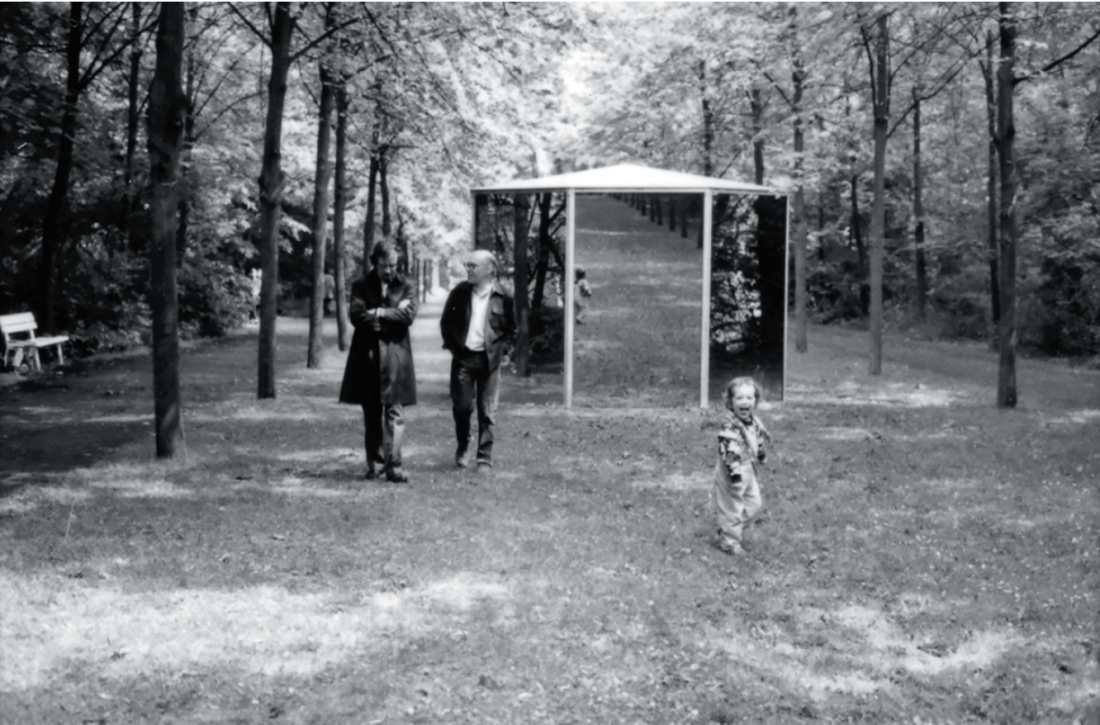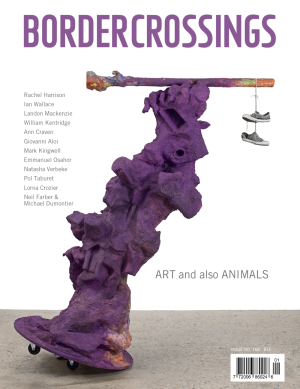“Exit Interview: Benjamin H.D. Buchloh and Hal Foster” by Benjamin HD Buchloh and Hal Foster
Exit Interview comprises three engaging dialogues between Benjamin HD Buchloh and Hal Foster, and concludes with a coda written by Buchloh, titled “Words of Mouth, Ends of Critics.”

Exit Interview: Benjamin H.D. Buchloh and Hal Foster, by Benjamin HD Buchloh and Hal Foster, published by no place press, San Francisco/New York, 2024.
“Part 1: Biographemes” concerns Buchloh’s own biography. Among other things, we learn that in 1959, at age 17, he attended Documenta 2, describing it as an event in which Germans confronted “the history of the modernism they had destroyed.” As a student in Berlin in 1969, he was present when Theodor Adorno was booed during a lecture and, in retrospect, agrees with Adorno’s assessment of the students as “fascist children re-enacting the fascism of their fathers.” He was good friends with Gudrun Ensslin prior to her radicalization as a member of the Baader-Meinhof group. When political pressures became too intense, Buchloh quit Berlin in 1971 for London, joined a commune, did drugs and wrote fiction, à la Kafka and Robert Walser. At 30, he returned to Cologne and got a job as assistant to the gallerist Rudolf Zwirner. Then, on Gerhard Richter’s recommendation, he got a position at the Dusseldorf Academy, but low pay persuaded him to leave when, in 1977, a position came up at Nova Scotia College of Art and Design in Halifax. After marrying the artist Louise Lawler, he taught briefly at California Institute of the Arts. Following a lecture at the University of California, Los Angeles, Buchloh recounts being attacked by faculty member OK Werckmeister, who said, “What you do is neither art history nor art criticism. What you do is propaganda. You’re like Goebbels.” Invited in 1981 to participate in a conference at University of British Columbia in Vancouver, Buchloh met Clement Greenberg for the first and only time, describing him as “unpleasant, haughty, dismissive of everybody. His time was up.” After completing his PhD in the mid-’80s at the City University of New York Graduate Center, he wrote for Artforum and October, and held numerous academic appointments until his retirement from Harvard in 2021.
“Part 2: Schisms” outlines Buchloh’s critical methodology, mentioning artists he has been particularly supportive of (including Marcel Broodthaers, Hans Haacke, Michael Asher, Dan Graham, Martha Rosler, Lawrence Weiner, Allan Sekula, Louise Lawler, Andy Warhol and Gerhard Richter) and those he later dismissed as having become too “subservient to the spectacularization of culture” (particularly Daniel Buren and Donald Judd). One aspect of Buchloh’s criticism that has held him in favour over the years, despite the image of uber historian, has been his consistent engagement with contemporary art.
At one point, Foster wonders if, by championing certain artists, Buchloh hasn’t projected onto them the role of critic, theorist or historian. Although Greenberg is not named here, Foster’s implication recalls his construction of a so-called managerial avant-garde that included, most prominently, Morris Louis and Kenneth Noland. Buchloh admits that he has on occasion “ascribed to these artists something different from what they actually did.” But Foster’s point is more that Buchloh establishes an incredibly high bar, thereby inevitably setting himself up for disappointment. By way of response, Buchloh poses a question worth repeating here: “Why are some artists, such as Haacke, Rosler, and Lawler, able to sustain structures of resistance within their practices while others, who were once critical of the socio-economic framework within which culture is produced, yield, at some point, to a more or less blatant affirmation of the underlying ideological and economic principles of the culture industry—that is, the legitimation of spectacle and the status of the artwork as a commodity for speculative investment?” An important question that contains numerous answers. But the situation is not as cut and dried as Buchloh makes it out to be: the past problematics of a type of Sartrean commitment no longer applies in quite the same way; today there is an ever-expanding area of indistinguishability between the means of artistic practice and those of politics.
Buchloh can be reductive in his somewhat orthodox assessment of certain practices, as with his comparing James Coleman and Jeff Wall, which Foster sums up well as “an opposition between a melancholic practice that contemplates cultural ruins (Coleman) and a reparative practice that seeks some sort of art-historical redemption (Wall), but that too is a rather stark binary.”

Michael Asher, Benjamin HD Buchloh and Felix Lawler-Buchloh in front of pavilion by Dan Graham for the exhibition “SKULPTUR PROJEKTE MÜNSTER,” 1987. Photo: Louise Lawler.
“Part 3: Dissensus” begins with reference to a 1986 charged discussion when Buchloh pointed out to Richter a central schism inherent to his practice: “You align your own painting with this antiaesthetic impulse and at the same time you maintain a pro-painting position.” An ambivalent position but one that has proven productive for Richter, as Foster observes; and who then turns the tables, wondering if Buchloh himself isn’t exempt from this type of contradiction by his occasional admiration of the complexity of bourgeois culture. Buchloh’s response is as concrete as it is dissembling, insisting that he has always emphasized the activist dimensions of artistic practices: “You cannot mourn the loss of bourgeois culture when you advocate the work of Allan Sekula.” It would seem that Buchloh’s position, however seemingly diverse or contradictory, is reflective of—and has always been informed by—those very artists he has championed all along.
Toward the end of “Part 3,” we come full circle when Buchloh states: “For better or worse, conditions have changed so dramatically in the last ten years that I feel my time as a critic is done,” thus recalling what he had earlier said about Greenberg. Perhaps Foster arrives at the crux of the matter when he later asks: “How, as a profoundly anti-institutional critic and historian, do you reflect both on your part in the institutionalizing of artists and critics and on your own status as a critical institution in your own right?” Buchloh choses to respond in the affirmative, expressing amazement at the generosity of his interlocuter’s assessment, but reminds Foster that his writing—lacking in post-colonial thought, critical race theory, radical feminism and the deconstruction of bourgeois Oedipality—does not warrant the status of a model. Foster is left to conclude that Buchloh is his own harshest critic. If only all critics could be so harsh.
In the coda “Words of Mouth, Ends of Critics,” which closes the book, Buchloh provides something of an overview, tracing the gradual demise of the critic’s role, identifying, as a central cause, the dominance of “universal equivalences” that emerged as a consequence of the globalization of culture, resulting in a subsequent disqualification of any hierarchical evaluations. “The universal politicization of artistic practices,” he states, “cannot tolerate the meddling voice of a critic’s attempt to differentiate and secure viable practices and positions from mere political posturing.” Finally, there is, too, the assimilation of the stock market and the art market, “a system of investment and financialization [that] not only no longer require any critical input but quite explicitly disqualify it.” Yet, despite the grave tone here, and however much one may empathize with Buchloh’s critical negativity, his sounding the death knell on art criticism, one suspects, may be more a prompt to future generations than a prognosis of termination; at least, some readers may choose to interpret it as such. A pronouncement of death may harbour within itself the suggestion of a reset, a transformation of sorts. Read between the lines, Exit Interview seems to suggest as much. ❚
Exit Interview: Benjamin H.D. Buchloh and Hal Foster, no place press, New York and San Francisco, 2024, 184 pages, paperback, US$34.
Arni Haraldsson is an artist and writer based in Vancouver. He is Emeritus Associate Professor at Emily Carr University of Art and Design.

